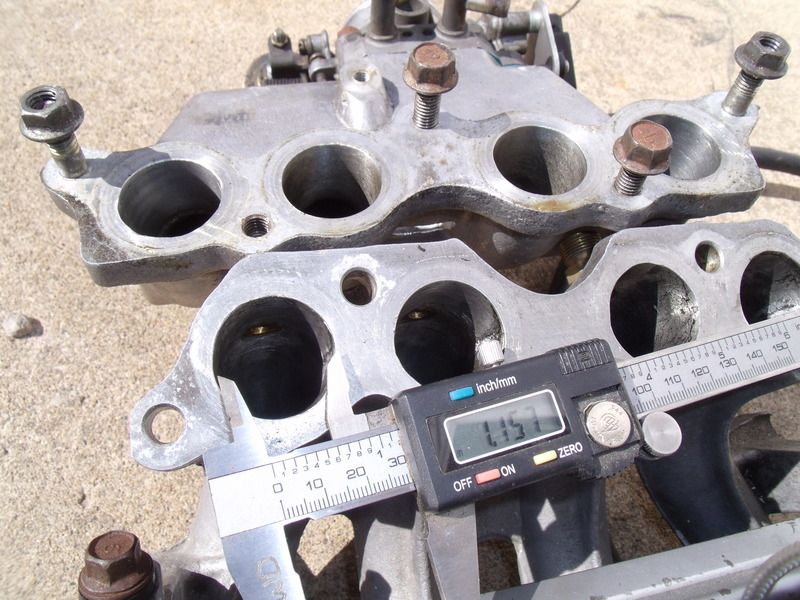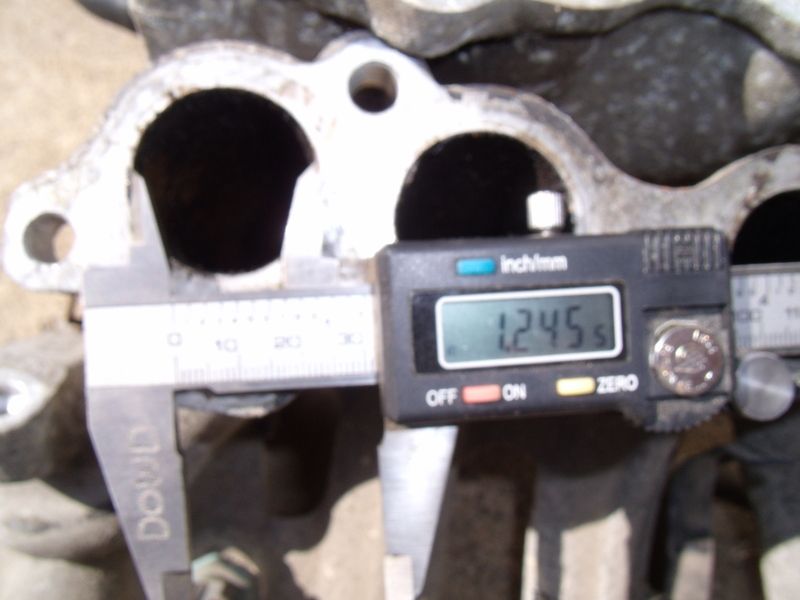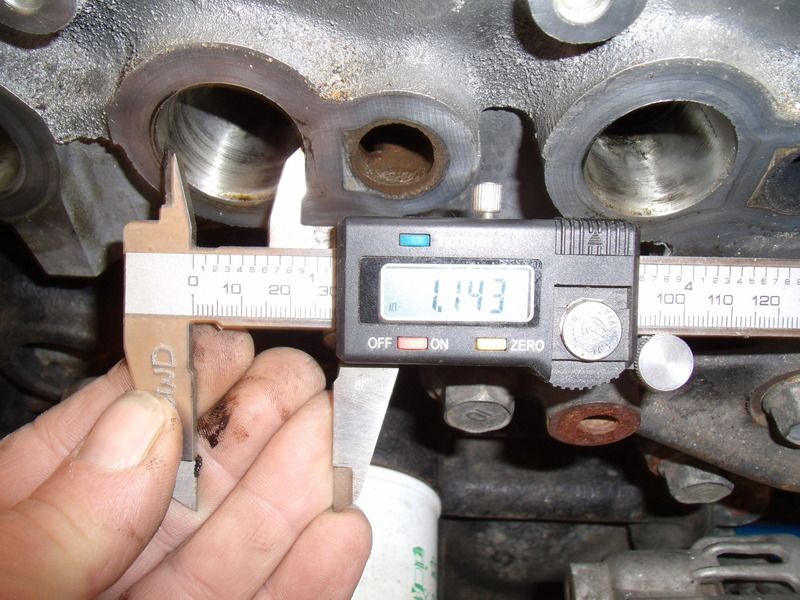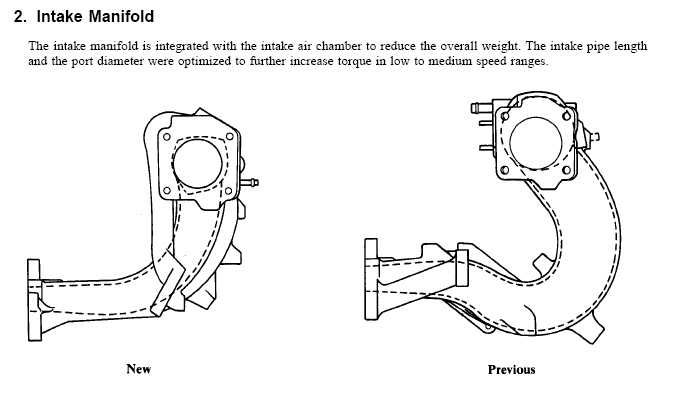
I'm wondering if I should upgrade the intake manifold on my 1.3L Festiva powered Miata. The car was built as a gas mileage project so any improvements to performance without sacrificing MPG is the goal.
The first photo is an upper and lower manifold from a 93 Festiva. The ports more or less measure at 1.15 inch all the way to the cylinder head... meh, it is what it is.
the second photo is a 94 Aspire manifold the upperports measure at 1.15 inch, the same as the Festive. however the lower manifold the ports measure at 1.24 inch!
Looks like the upper section of the Aspire manifold could be enlarged to match the lower giving a 1.25 inch tunnle right up to the head.
Unfortunately the head has tiny 1.14 diameter ports.
Obviously the head is a bottleneck and I dont want to carve out the ports... so would the larger manifold be of any benifit?
With the smaller manifold the engine hits its 5000 RPM rev limit without struggling .
This sort of stuff is above my paygrade . What kind of train wreck am I looking at.
 Festiva manifolds measure 1.14 inches
Festiva manifolds measure 1.14 inches
 The lower Aspire manifold is a huge 1.24 inch. Me thinks the upper manifold could be easily modified to match
The lower Aspire manifold is a huge 1.24 inch. Me thinks the upper manifold could be easily modified to match 
 Bottleneck at the head...
Bottleneck at the head...

bluej
SuperDork
3/1/16 10:38 p.m.
in for discussion on flow velocity filling efficiency vs. runner size filling efficiency.
Seems like you'd leave it alone at the small size of the port in the cylinder head out to the plenum. Seems like the best way to keep fuel in suspension and not puddle at the port of the head.
But I don't do anything with this stuff besides read so grain of salt the size of that piddly little intake port.
How far out can you take the head? Once you know that you can open up the manifold accordingly. Flow match even the gaskets, it only increases top end doing all this, if the cam is designed for 5,000rpm peak you won't gain much from this mod anyways. With head flow mods it's go big or go home. Go All in or live with the sloth.

DrBoost
UltimaDork
3/2/16 5:31 a.m.
Personally, I'd match-port the head to either manifold. You'll gain performance, which is just another way to say efficiency. The MPG boost or dip will depend on your right ankle and how you choose to use that efficiency. But....there are a lot of folks on this board that are far, far smarter than me so listen to me like my wife does, with a half smile and a glazed look in your eye.
pres589 wrote:
Seems like you'd leave it alone at the small size of the port in the cylinder head out to the plenum. Seems like the best way to keep fuel in suspension and not puddle at the port of the head.
But I don't do anything with this stuff besides read so grain of salt the size of that piddly little intake port.
It's fuel injected. The fuel doesn't even show up until the manifold/head interface. And it's probably aimed right at the valve.
I'm with Doc on this one- port matching is the most important thing. Don't add any restrictions that are not helping.
Heck, if it were me, I'd look at adding things like EGR to increase fuel economy (and yes, it can- and was a very popular tool when this engine was made in the late 80's/early 90's). Or perhaps put it back in.
I think that increasing the port size would benefit high-end performance only, above your 5000 rpm limit, and not do much (or even hurt) performance below that.
homework
Read all the articles in this link. It should help you make your decision
interesting...
What get me confused is the Aspire manifold was manufactured with mismatched port sizes. Why would they put larger runners on the lower manifold and keep the cylinder head at 1.4 inch?
Both the Aspire and Festiva are rated at 63HP at 5000 rpm. The torque curve is also the same.
The major differenced between the engines is the Festiva uses camshaft EGR effect and the Aspire has a proper EGR valve. A point to note, my engine has been fitted with an Aspire camshaft.
The Aspire engine is sequential injection and the Festiva is batch. My engine is set up with megasquirt and batch injection.
When they manufactured the Aspire, they pitched the smooth flowing cast iron exhaust manifold used in the Festiva and went with a complex ill flowing tubular exhaust manifold.
I wonder if the larger runners on the Aspire manifold have something to do with the sequential injection and the EGR?
Probably tapers for a reason, most intakes do.
The smaller Festiva manifold is going back on the engine for the time being.
I'm toying with the idea of cleaning up the Aspire manifold complete with EGR and doing an experiment.
Bigger is not always better.
Doc Brown wrote:
The smaller Festiva manifold is going back on the engine for the time being.
I'm toying with the idea of cleaning up the Aspire manifold complete with EGR and doing an experiment.
When you add EGR, remember to add spark. That's one of two big benefits to EGR.
alfadriver wrote:
Doc Brown wrote:
The smaller Festiva manifold is going back on the engine for the time being.
I'm toying with the idea of cleaning up the Aspire manifold complete with EGR and doing an experiment.
When you add EGR, remember to add spark. That's one of two big benefits to EGR.
Yep, running lean of stoich and running EGR both need more spark advance, as the burn will get slower with the more diluted mixture. Both can give a noticeable mpg gain when implemented well.
LSJuan? Is that the Answer you're looking for? 
In reply to Stefan (Not Bruce):
this isn't that kind of project. Quite the opposite, in fact.

Doc Brown wrote:
With the smaller manifold the engine hits its 5000 RPM rev limit without struggling .
Without a flowbench checking it.... I'd leave it alone.... larger manifold may hurt velocity.....
On my 4AF I was able to boost low end power (torque) in a few ways... one was to swap intake manifolds to a smaller one

Now if you we going to put a longer duration camshaft in, then I might consider looking at a different manifold.... BUT before I'd be worrying about the manifold, I'd be looking closer at optimizing the valves, valve seats, and bowls.
edit -
Doc Brown wrote:
interesting...
What get me confused is the Aspire manifold was manufactured with mismatched port sizes. Why would they put larger runners on the lower manifold and keep the cylinder head at 1.4 inch?
To improve airflow.... at least that is a possible reason... When air is directed into a smaller pipe from a larger pipe, the air tends to eddy at the edges of the larger pipe. A cross section of this would show the eddys acting like a velocity stack.
Unless hp is the primary goal, I would leave the smaller runners. Make sure you are running O2 correction when tuning the EGR in, it makes things quite a bit simpler. As said before, if you get surging, add advance to help until it doesn't help anymore. That's the limit of the amount of EGR you can run.

DrBoost
UltimaDork
3/2/16 11:01 a.m.
alfadriver wrote:
I'm with Doc on this one- port matching is the most important thing. Don't add any restrictions that are not helping.
Hey, I was right!! You were one of those smarter-than-me guys on this board I was thinking about. So if you agree with me, I has smart.
I would port-match for sure. I've done it pretty much anytime I've had a head off (on a 4-banger, once one manifold is off, it's not much more to get the head off). No matter if the manifold has a taper or not, you don't want a sudden step down like that anywhere. I'd port-match the two manifold halves and the head-to-manifold ports (both intake and exhaust) and go from there. You'll be pleasantly surprised.
Cool! The Aspire manifold is ugly as sin, but in the name of science I'll make this experiment happen. The EGR aspect has captured my interest. Thanks for all the input!
alfadriver wrote:
In reply to Stefan (Not Bruce):
this isn't that kind of project. Quite the opposite, in fact.
Really? Are you sure about that? because it seems like that's all we've been talking in this thread. 
Stefan (Not Bruce) wrote:
alfadriver wrote:
In reply to Stefan (Not Bruce):
this isn't that kind of project. Quite the opposite, in fact.
Really? Are you sure about that? because it seems like that's all we've been talking in this thread. 
Porting, sure, but I'm not sure that LS Juan is an answer for an car that the engine was downsized from a 4v 1.6l to a 2V 1.3l engine just to get fuel economy.
Unless, of course, the LS can get 45mpg in a Miata....
LS may not be the answer, but an older VW TDI probably is... That would get pretty sweet mpg in a Miata.
In reply to rslifkin:
Much like the Free Lotus Europa, there was a diesel Miata floating around for a few years on the board.
Whereas this project has been driven. It helps a lot that the engine swap was between close relatives- so that much of it was just a bolt together.
Good idea, in concept.
I want that Miata with the diesel motor in it. The last time it came up for sale it was still to far south to make getting it practical (and then there is the issue of how many cars I have in my yard) Anyway it would b interesting to know what happened to that car.
 Festiva manifolds measure 1.14 inches
Festiva manifolds measure 1.14 inches![]()
 The lower Aspire manifold is a huge 1.24 inch. Me thinks the upper manifold could be easily modified to match
The lower Aspire manifold is a huge 1.24 inch. Me thinks the upper manifold could be easily modified to match ![]()
 Bottleneck at the head...
Bottleneck at the head...![]()








































